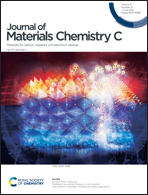Light induced transformation of resistive switching polarity in Sb2S3 based organic–inorganic hybrid devices†
Abstract
A complexation strategy has been demonstrated for the fabrication of an organic–inorganic hybrid system, where the organic molecule aniline acted as a ligand for the complexation of antimony chloride. By the addition of a sulfide source (sodium sulfide) to the complex medium, an organic–inorganic composite system (aniline stabilized antimony sulfide) was developed. X-ray diffraction analysis confirmed the formation of orthorhombic antimony sulfide and the microscopic images showed the formation of highly dispersed sulfide nanoparticles on the organic matrix. The optical characterization exhibited changes of characteristic vibrational bands in the FTIR spectrum that support complexation and the particle formation process. The as-synthesized product, aniline stabilized antimony sulfide, was applied as an active material of a device to extract the electrical properties under normal laboratory illumination (LED) and UV irradiation conditions. The device exhibited unipolar and bipolar switching behaviours under two different optical conditions with a moderately high ON-to-OFF ratio. The transport mechanism of the aniline stabilized antimony sulfide-based device was followed by Poole–Frenkel, Ohmic and Schottky emission at different conduction states. The device showed a persistent endurance behaviour, and statistical analysis suggested a stable high conduction state (HCS) and low conduction state (LCS) under LED and UV irradiation conditions. Furthermore, the impedance measurement of the device over the frequency range from 100 Hz to 1 MHz under both LED and UV irradiation conditions was performed to find out the device equivalent circuit and AC conductivity behaviour.



 Please wait while we load your content...
Please wait while we load your content...